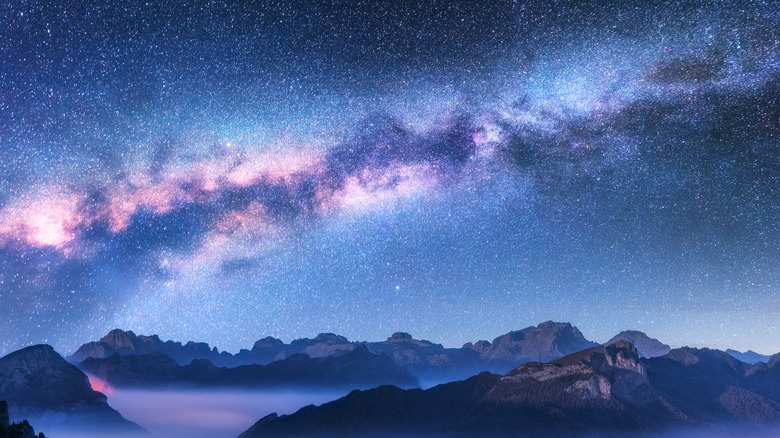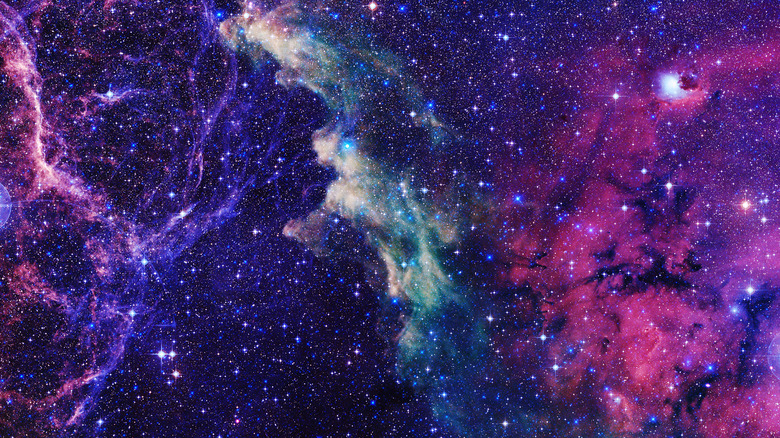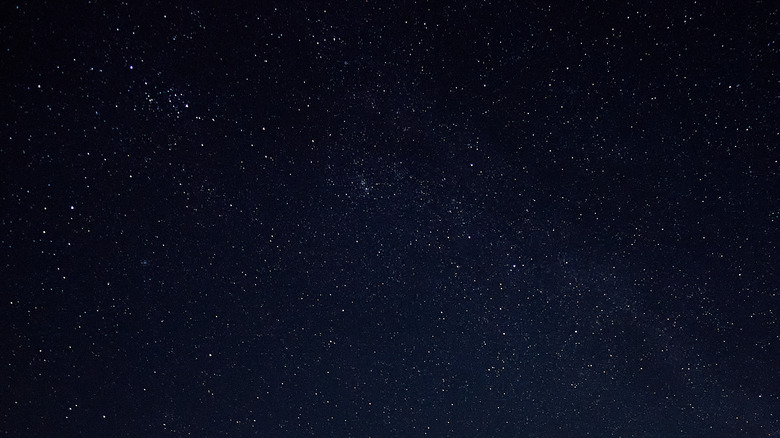Will The Milky Way Galaxy Last Forever?
When staring up at the nighttime stars, it's easy to forget that they, too, will die. In comparison to the brief dust of a single human life, with a very visible beginning, middle, and end, bound to an Earth defined by interwoven ecological cycles, the stars do indeed seem eternal. But it's taken 13.8 billion years since the Big Bang to reach the point where we can even make such an observation. And it will be many more tens of billions of years, too, until every last star in the universe winks out, and our own Milky Way galaxy becomes nothing but a black panorama of single, zipping particles too spaced out to ever collide.
The Milky Way galaxy, our cosmic lookout porch, is a 100,000-light-year-wide spiral galaxy with a supermassive black hole at its center. Our sun is merely one of 100 billion stars in its expanse (per NASA), and our single galaxy is but one of two trillion within the observable universe, as Forbes explains. And the observable universe? It's a mere 1/250th of the entirety of the cosmos, a 23-trillion-light-year-wide reality over 15 million times greater in volume than anything we will ever see or visit, because the universe is expanding at a rate faster than the speed of light.
The (relatively) short-term fate of the Milky Way, though, isn't bound to the death of its stars, but the collision between us and our neighbor, the Andromeda galaxy.
No more new stars beyond the cosmos' Stelliferous Era
Before we dive into the fate of our Milky Way galaxy, we've got to take a little foray into the life cycle of stars themselves. Like humans, rosemary bushes, gypsy moths, or any other terrestrial life form, stars are born, pass through phases, and then die. So do entire galaxies, and beyond them, the universe itself.
Our own sun is a good reference point. In a 13.8-billion-year-old universe, the sun is a modestly-sized, modestly-hot yellow dwarf star about 4.5 billion years old. Its core is 15 million degrees Celsius (27 million degrees Fahrenheit) (per NASA), and its gravitational pull extends beyond Pluto and up to two light years (per Universe Today). As Astronomy explains, it faces the same end as every single star in the Milky Way and beyond: go quietly into that good night in a shrunken, white-dwarfed fuel-burning fizzle, or explode in a supernova and scatter its remnants everywhere.
But here's the thing: There will eventually be no new suns, anywhere. This is the only era of the universe — the second era of five — when stars can be born. And this era, the Stelliferous Era, which lasts from cosmological decades 6-14 (years 6 to 14 billion), is nearing the end (per Big Think). At 13.8 billion years old, we've got about 200 million years to go. After that, stars will only die, and occasionally form new specks of light in the sky when they collide with each other.
Milkdromeda: the fused offspring of the Milky Way and Andromeda galaxies
So how long does a star live? It depends on the mass. Very large stars, as Sky and Telescope says, can go supernova in only a few million years — a relative blip in the cosmic night. Smaller stars like our sun, however, can run on their fusion tanks up to 10 billion years. The Milky Way is full of a variety of such stars that will all continue to age. About 5 billion years from now, as Astronomy explains, our sun will start to transition to its red giant phase. By about 8 billion years in the future, it'll consume the inner planets: Mercury, Venus, and yes, Earth. Our solar system's habitable zone will be Jupiter and Saturn and their moons.
Before then, any creature still alive on Earth will get a chance to behold the Milky Way's fate before its approaches the same, inevitable disintegration facing the entire cosmos. As Kottke expertly illustrates, about 2 billion years from now the Andromeda Galaxy, a spiral galaxy about 2.5 million light years away, will start to grow larger and larger in our night sky. Eventually, it'll clash with our own galaxy and swirl into a new nebula of gases and intermingled star systems to form the fused, new galaxy "Milkdromeda." That's when the Milky Way, technically, will cease to exist.
While it's possible that individual stars might collide, it's unlikely because of the amount of emptiness in space.
The stars of Milkdromeda will face the same fate as all stars
Milkdromeda will burn onward through the Degenerate Era of the cosmos (cosmological decades 15-37), when our sun will lose all of its hydrogen, start to shed helium, and enter its red giant phase. After that, it'll shrink into a white dwarf and eventually a black dwarf: the end of a star's life cycle and fizzled-out companion to a black hole, which forms when a sun goes supernova. At 13.8 billion years old, the universe is still too young to have created any black dwarfs, as Space says.
Beyond the Degenerate Era, through the Black Hole Era (cosmological decades 38-100) and into the Dark Era (past cosmological decade 100) all stars in Milkdromeda will wink out one by one. Black holes will consume everything, including other black holes, and grow bigger and bigger until they, too, eventually expel all the energy they've captured and leave in their place absolutely nothing at all. The entire universe will be locked, permanently, in a state of absolute zero. There will be no more heat because there will be no more energy difference between anything. Our chilled, starless cosmos will look like a dark dream of peace fulfilled.
So will the Milky Way galaxy live forever? Of course not. This can be a terrifying thought, sure, but it can also be a very good reason to gaze up into the sky and appreciate the one, brief epoch when such wonder is possible.



